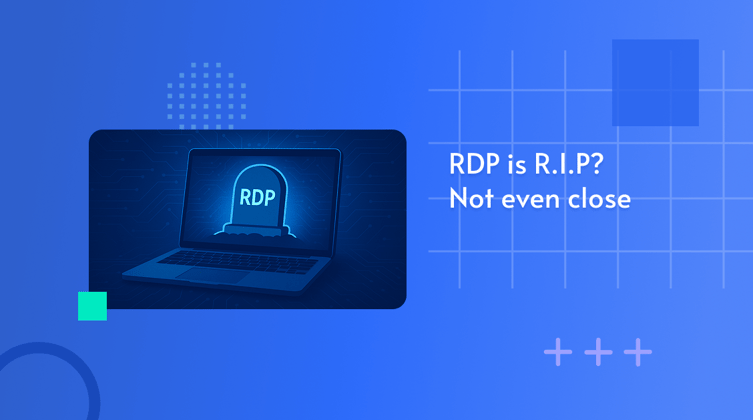We may have known it for a while, but now we are officially cool! Remedio was ju...
Why RDP Threats Never Die: A New Twist on an Old Risk

It seems like every time we think we've closed the door on Remote Desktop Protocol (RDP) threats, another window opens — sometimes quite literally.
In recent years, RDP has become a persistent target in the attacker’s toolkit. From the wormable BlueKeep vulnerability in 2019, to brute-force password attacks during the pandemic-era remote work explosion, to the more recent discovery that cached credentials can allow access even after a password reset, RDP continues to be a source of “features” that undermine enterprise security.
And now, a new critical RDP vulnerability (CVE‑2025‑48817) reminds us that this protocol’s design — and trust model — remains dangerously exploitable.
The Problem Isn’t Just That RDP Is Vulnerable — It’s How It Fails
When we talk about RDP risks, most people imagine weak passwords or open ports.
But the real danger lies deeper: in the way RDP bends the rules of identity, access, and trust.
Let’s recap two recent examples that show how legacy design decisions are colliding with modern threat models:
Cached Credentials: A Quiet Catastrophe
Earlier this year, it came to light that users can log into Windows machines via RDP using outdated credentials — even after a password has been changed in Azure AD or Entra ID.
Why? Because Windows caches those credentials locally. And RDP checks those caches first — before verifying against the cloud.
Microsoft's response? It's not a bug — it’s intended behavior, meant to allow users to access offline machines without losing access after a password change.
But in practice, this means:
-
MFA is bypassed
-
Conditional Access is rendered useless
-
Revoking credentials doesn't revoke access
Cached credentials become a silent backdoor — especially dangerous in breach response scenarios where a password change is often the first line of defense.
CVE‑2025‑48817: When the Server Attacks the Client
The newest twist comes from CVE‑2025‑48817, a critical vulnerability affecting the RDP client, not the server.
Here’s how it works:
-
A user initiates an RDP session to a remote server.
-
That server has been crafted maliciously.
-
Through a path traversal bug, the server executes code on the client machine.
This attack vector is particularly concerning because it reverses the typical client-server trust model — where the client is vulnerable because it trusts the server.
Now the danger flows in the opposite direction. And all it takes is one mistakenly trusted RDP session to compromise a machine.
What This Tells Us About the RDP Threat Landscape
These vulnerabilities aren’t isolated bugs. They’re signs of a deeper issue:
RDP was built for a world that no longer exists.
A world where:
-
Passwords were trusted forever
-
Access was static and predictable
-
Offline access was more important than revocation
But today’s enterprise is dynamic. Identities shift. Threat actors move laterally. Remote access is ubiquitous — and often abused.
The fact that old credentials can still work — and clients can now be compromised by servers — reflects a failure to align RDP with modern zero-trust principles.
How to Defend Against RDP’s Shape-Shifting Threats
At Remedio, we help organizations close the RDP security gap by focusing on configuration hardening and real-world enforcement — not just patching.
Here’s what we recommend:
Disable RDP Where It’s Not Needed
Most organizations have far more RDP exposure than necessary. Remedio helps you identify machines with no business reason for remote desktop — and disables access in one click.
Delete Cached Credentials Automatically
Remedio continuously discovers and wipes cached credentials across your environment — without requiring manual scripts, Group Policy tweaks, or restarts.
Enforce Strong Defaults
We ensure Network Level Authentication (NLA) is enforced, SMB Signing is enabled, and legacy protocols are removed — across all endpoints.
Respond Faster
When credentials are changed, Remedio ensures those changes are respected locally — eliminating silent trust gaps that attackers love to exploit.
Take Control of RDP Before the Next Variant Hits
The RDP threat isn’t going away — it’s evolving. And every new CVE is a reminder that attackers are adapting faster than traditional defenses.
It’s time to stop relying on password resets and patches alone.
Remedio gives you the visibility, control, and automation to close RDP-related gaps — permanently.
About Author

Ilan Mintz
Subscribe to
our Newsletter
We are ready to help you until and unless you find the right ladder to success.
Related Posts
Join over 25,000 in beating the failure of strategies by following our blog.
Six years ago, we set out with a simple but ambitious mission: to make enterpris...
3 minute read
If a threat falls in the SOC and no one ties it to revenue, does it really make ...
7 minute read
Active Directory (AD) is the powerhouse of the enterprise — the central hub wher...









Comments